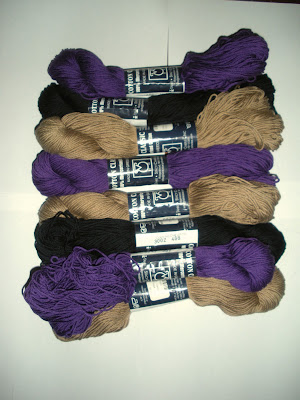Part I covered washing the fleece,
Part II covered prepping it,
Part III covered spinning singles, and
Part IV covered plying and finishing yarn. This part will cover starting to knit the shawl.
I know it has been awhile. I had to spin and ply a third skein for the project, then I put it on hold while I finished some presents for the holidays. But last week, since I finished the astronomy hat, I decided to jump into the next step with both feet.
So, what is the next step? Choosing a pattern.
I knew that I wanted to do a lace shawl, but that still leaves a lot of patterns.
The first step to choosing a pattern is to set parameters. So, these were my parameters:
- Lace
- Looks good in white (no dyeing for me!)
- Rectangular
- Uses lace-weight yarn
- Airy
- Minimal looking at the pattern required (nothing where each row is unique)
As you can tell, some of these were structural, and some were design elements.
The next step, for me, in choosing a pattern, is to look through my stitch dictionaries to see if there was any stitches I could use without modification. I like using the stitch dictionaries, because it allows my piece to be "mine," but I didn't find anything that particularly inspired me.
After that, I looked through my lace books. I didn't find anything that matched my criteria - most of the shawls available were not rectangular (though beautiful, I may have to go back and do another some day).
Finally, I used
Ravelry's pattern search. Some of my criteria (lace, rectangular, uses lace-weight yarn) could be put into the search directly. Other criteria would have to be judgement.
My final selection was the
Lattice Lace Wrap designed by Lou Schiela, although I will be skipping the beading.
Something in the pattern just called to me. It was nice and repetitive, without being boring. I like criss-cross patterns - someday soon I will do a post on entrelac. It looked very airy, and could be expanded to a different width without much trouble.
Before I made the plunge, though, I had to do a test knit or two. These are especially important for hand-spun, since there is no other way to get a gauge - My finished yarn looked lace-weight to me, but there was no way to make sure that it would work in the pattern, or which needles to use, without testing.
I did two test swatches. The first, on size 5 needles:
 |
| Lace swatch #1, unblocked |
The second was on size 6 needles:
 |
| Lace swatch #2, unblocked |
If I was a good planner, I would have blocked them and measured the gauge, maybe kept them in my pocket for awhile to test their wearability, put them through the wash, and otherwise tested them to see how the shawl will look over time before starting to knit. I recommend that you do these things, especially if you are making a shaped garment.
But I don't have the patience. I started knitting right away, as soon as I chose my needle (size 5, I think it looked a little nicer that way), and have one repeat of the pattern finished.
 |
| A good start on the shawl |
 |
| Close up |
And, even though I have already started knitting the shawl, I did do a light blocking of the swatches to see how they might turn out. I am worried that the pattern won't be very visible without the beads.
 |
| Swatches, lightly blocked (no pins) |
It should be awhile before I do another of these posts. The shawl is likely to take a long time to complete. But I will attempt to amuse you in the mean time with other projects.






























